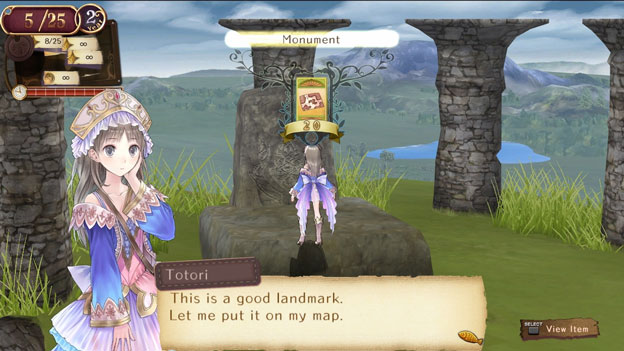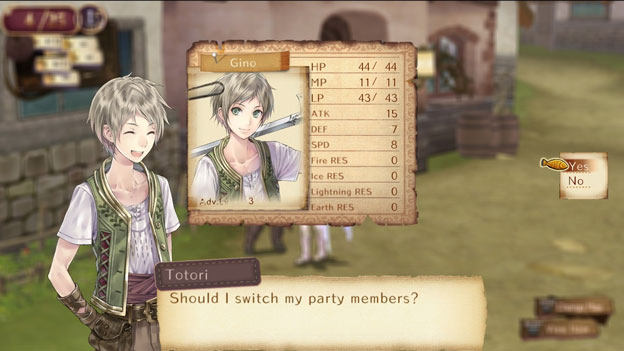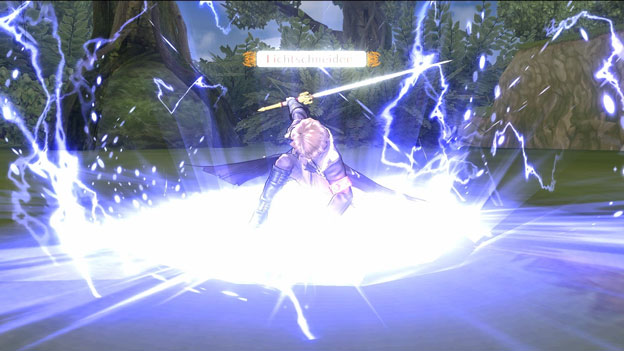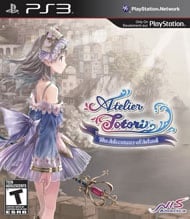Growing Up the Hard Way
Totori Helmond has a problem. Her famous adventurer mother disappeared years ago and is presumed dead, but Totori believes she’s still out there somewhere. Unfortunately, Totori isn’t her mother; she’s naive, clumsy, and not very smart. The only thing she does well is stir cauldrons, concocting magical mixtures that help herself and others. With this power of alchemy and the help of a few of her more athletic friends, Totori sets off to become an adventurer so that she can survive the perilous journey to find her mother.
Atelier Totori is the second in Gust’s Arland series, which began with last year’s Atelier Rorona. In fact, Rorona is Totori’s alchemy teacher, and several other characters from that game are major players in Totori’s adventure. Both games feature small, personal stories rather than expansive fantasy epics, which is a nice change from the usual JRPG fare. In both games, the player must travel to different locations, fight monsters, and gather ingredients, then use alchemy to process those ingredients into useful items. The goals of the two games, however—as well as many of the mechanics—are different.

While Atelier Rorona restricted itself to the immediate area around the City of Arland, Totori is able to traverse the entire continent and even a bit beyond it. One of Totori’s major goals is to rank up as an Adventurer of Arland, which she does by earning points for completing a variety of goals. With every rank, Totori gains access to more of the world, and thus is able to fight stronger monsters and collect better alchemy ingredients. Since she can earn points for exploration, battling monsters, completing quest-style requests, and creating alchemical items, the game is rather free-form and allows the player to choose among a variety of tasks at any time. It’s a particularly non-linear experience for a Japanese game, and should appeal greatly to explorer-type gamers.
Since Totori is, indeed, rather weak and clumsy, she never fights alone. Her companions are colorful characters such as her over-enthusiastic childhood friend Gino, the freakishly strong but fundamentally lazy Melvia, and the mad scientist Marc. Later on, Totori is able to adventure with the noble knight Sterkenberg and her teacher Rorona, who is fortunately stronger than she was in her own game. Totori builds up her friendship with her companions by traveling with them, as well as by giving them items that they periodically request from her. As she grows closer to her friends, she is able to view scenes with them, and if the player is lucky or is following a game guide, they may be able to trigger a “final event” that gives a bonus scene with a companion character at the end of the game.

Totori’s companions fight beside her in a basic battle system that should be familiar to anybody who has played a turn-based Japanese RPG. Characters attack with weapons and use mana points for character-specific special abilities. Only the alchemists, Totori and Rorona, can use items, which are essential in the game’s tough boss battles. As Totori is a terrible fighter, the player will want to use alchemy to synthesize plenty of bombs and healing items for her anyway. Weapons and armor are created using a combination of alchemy and a blacksmith’s shop, so the strength of the characters’ gear is linked to the quality of the ingredients that Totori has been able to gather in the field. The overall battle system isn’t particularly innovative, but it gets the job done in a game in which combat is only one of many focuses.
With a fairly simple battle system and a lot of freedom in terms of activities in which to engage, the main challenge of Atelier Totori comes from time management. For the first three years of the game, Totori is tasked with proving herself as an Adventurer, rising in the ranks by reporting in at the Adventurer’s Guild as she gains advancement points. Days pass as Totori moves around the map, harvests ingredients from gathering points in the areas she visits, fights monsters, and synthesizes items through alchemy. She ranks up very quickly at first, and players should have little difficulty reaching the required rank before the end of the third year. It’s the last two years of the game, in which Totori must travel far afield to maintain her adventuring status while searching for her mother and attempting to experience events with her companions, that become a big time-management challenge. Players looking to get as much as possible from the first playthrough are advised to speak to all the main characters on a regular basis (to trigger as many time-saving features and events as possible) and keep an eye out for alchemical recipes that reduce travel time.

Atelier Totori’s story becomes the main focus of the last two years of the game, as Totori is forced to grow up quickly in her quest to learn the truth of what has become of her mother. It’s a simple but touching story with some unexpectedly emotional twists, especially considering the usually lighthearted nature of the game. The player’s actions during the game help to determine the ending, a nice touch that gives the game plenty of replay value.
The excellent graphics and lovely soundtrack add a great deal to the overall experience of the game. The game sports gorgeous cel-shaded graphics, which shine particularly in some of the more exotic locations Totori visits, as well as in the beautifully detailed character models. Although conversations and events still take place via 2D artwork, the 3D character models closely resemble that artwork and sport some very impressive-looking combat moves. Much of the game is a pastel-colored feast for the eyes, which is backed up by a high-quality, evocative soundtrack. The many excellent tracks are marred only by some of the music around Arland City, which can be a bit grating with repetition. The English voice acting is somewhat hit or miss, but fortunately players have the option of listening to the Japanese voice tracks instead should Totori’s slightly whiny voice prove a bit too much to handle.
While Totori’s story and systems are mostly improved in comparison to its more limited predecessor, there are a few oddities and weaknesses to be found. Despite taking place over five years and marking every day on the in-game calendar, the game plays a bit fast and loose with time. At the very beginning of the game, Totori is told that she has a month to raise a certain amount of money in order to receive her Adventurer’s License, but the game actually allows several months to go by before Totori is asked to produce the money. This makes the beginning of the game rather confusing and boring, as Totori only has access to two simple adventuring screens at first. Fortunately, it opens up swiftly once Totori finally gets her hands on that license.

Additionally, since Totori starts the game at age thirteen, she should be seventeen or eighteen by the end. Unfortunately, the game makes no visual or story-related references to her maturation. Totori still looks like a pre-teen at the end of the game, and though she’s told that she’s “grown up” a fair bit, there’s no indication that she’s actually grown any older. Though she has gained experience and become more confident in herself, she doesn’t begin to experience the kind of maturation that occurs throughout one’s teenage years. This is a definite weakness in a game that is all about the journey from innocence to experience. It would have been easier to take if the game had simply taken place over two or three years with a reduction of the amount of time it takes to perform every action.
Finally, although Totori has three basic endings and additional added-on scenes available after meeting , the game gives no indication as to how to obtain these different endings. It would have at least been helpful for the game to indicate when and where a character event is available, as the only way to see many events is to happen to speak to a particular character or walk into a particular location during the correct time frame. Especially on the first playthrough, most players are only going to be able to obtain the “normal” ending for the game rather than the “true” ending and the additional mini-endings without the help of a guide, which is a bit of a disappointment.
Still, for fans of this kind of personal adventure story, Atelier Totori is a great game with a ton of replay value. The open world conveys a great sense of adventure and exploration, the player has a lot of choice in how to play out Totori’s adventure, the characters are a great deal of fun to get to know, and the multiple endings will have many players coming back for more. Gamers who are looking for a fairly laid-back adventure with plenty of things to do and lots of fun characters to meet should definitely give Atelier Totori a try.
RATING OUT OF 5 RATING DESCRIPTION 4.5 Graphics
Atelier Totori features beautiful cel-shaded models and environments, along with lovely 2D art during conversations and events. 3.4 Control
The battle system is simple but workable. Players could use more guidance in order to make the best use of time in the game. 3.5 Music / Sound FX / Voice Acting
The soundtrack is excellent and evocative, though the English voice acting is hit or miss. The Japanese voice track is available for those who prefer it. 4.5 Play Value
Atelier Totori is meant to be played through more than once, with three basic possible endings, character-based add-ons to these endings, and far more things to do than can be done in one playthrough. 4.0 Overall Rating – Great
Not an average. See Rating legend below for a final score breakdown.
| Review Rating Legend | |||
|---|---|---|---|
| 0.1 – 1.9 = Avoid | 2.5 – 2.9 = Average | 3.5 – 3.9 = Good | 4.5 – 4.9 = Must Buy |
| 2.0 – 2.4 = Poor | 3.0 – 3.4 = Fair | 4.0 – 4.4 = Great | 5.0 = The Best |
Game Features:
